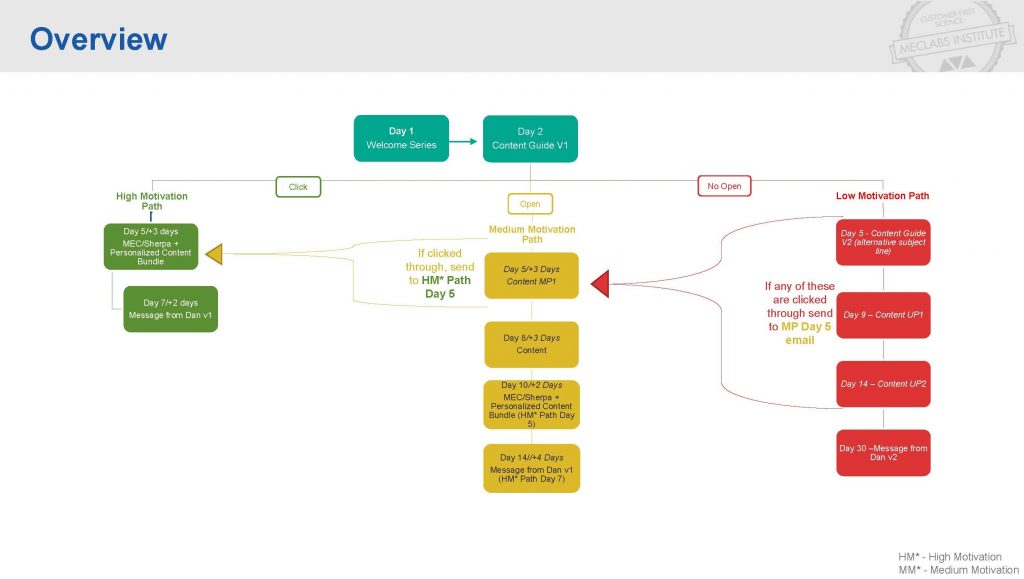Marketing 101: What is the happy path?
The happy path is a quick, linear path to the purchase of a product or service where the customer doesn’t get sidetracked, either by their own distracted actions or by a company’s poorly designed process or because the customer has a more complex use case. Let’s take a closer look at why this is important and how it might look.
The Value Exchange Happy Path
Often, companies require users to fit within certain criteria to be eligible for the simplest outcome.
An example of a happy path that MECLABS optimized with one of our Fortune 20 Research Partners would be the “Happy Path Upgrade Funnel.” The happy path would be what is experienced by a customer who chose to start the upgrade process with the following conditions:
- Fully paid off their old device
- Was upgrade eligible based on the rules of their phone plan
- Had no account problems they had to resolve in order to upgrade today
This would allow them to complete the upgrade funnel in the shortest, simplest number of steps possible and with the least amount of cost experienced as part of the value exchange.
In contrast, a non-happy path upgrade customer would be a person with a more complex situation:
- Must pay off their old device as part of the upgrade process
- Is not upgrade eligible based on their plan and would need assistance to find a workaround
- Has additional account level problems they must resolve before completing the upgrade process
In this case, the “unhappy path” would refer to a process that isn’t necessarily bad from a poor design perspective, but rather a customer funnel experience that veers from the simplest path to conversion possible, to account for the differences between users.
And let’s not forget that sometimes there are government regulatory requirements — similar to company requirements — but are required steps a customer must pass by law.
The Path of Motivation
It’s important that you anticipate more than one non-happy path scenario and map out how you would handle each situation. You can use the idea behind the happy path in your email marketing as well by including a high, medium and low motivation path for any automated or drip campaign you have. For example, a welcome series:
- If they clicked through on an email, they could be perceived as having higher motivation
- If they opened an email but didn’t click through, then they may just have a medium level of motivation
- If they didn’t open the email, it would indicate a lower motivation
Once you understand who your high motivation people are, figure out how you can make it as easy as possible for them.
MarketingSherpa’s Welcome Series for new email newsletter subscribers.
The Path of Error
I found myself on an unhappy path recently while doing my Christmas shopping online. After spending quite a bit of time — which is precious to me these days — choosing gifts for the important people in my life and then entering my address and other information for delivery purposes, I touched the CTA button “Order Now.” Nothing happened. I waited. Pressed it again, but the form page would not let me move on to the next step because it didn’t recognize my address. This online retailer’s address form only allowed for addresses that were recognized by the U.S. Postal system. But my home was new construction and it was not officially in its database yet. I contacted their customer service and explained the situation. After waiting 24 hours with nothing but an automated response email stating they’d contact me, I gave up and ordered my product from a different online retailer. I guess I’m a picky customer. I don’t have time for that. Can you relate?
The data shows that I am not the only picky customer out there. I represent a large segment of digital buyers. We are impatient, we are demanding — with high expectations. So try to avoid frustrating errors that will send your visitors off the path.
Even if your website developers have shored up all possible tech errors, a customer can get off the happy path because of a confusing page design, or misaligned expectations, entering a wrong credit card number, not reading your policies. Shipping issues could arise, something could be out of stock or damaged. The list is long.
But here’s the takeaway. Exceptional customer service covers a multitude of sins. It’s impossible to create a perfect path for every visitor, but you CAN make the journey pleasant even when customers find themselves on unhappy paths.
Recently, we offered a Black Friday Cyber Monday BOGO sale on our certification courses and training that lasted all week. The sale should have ended at midnight on Sunday night, but due to a technical error, the sale actually ended a few hours earlier. As soon as the error was noticed, we sent out an apology and extended the free course option for another two days. Now we could have just apologized but felt we needed to do something more to make amends.
Your competitor is just a click away, so make sure your responses to a happy path deviation are not only adequate but exceptional. Overdeliver consistently.
Related Resources
Rapid-Fire Results: Get quick ideas for improving your customer-first marketing
E-commerce: Why a forced checkout registration is never a good idea
Customer-First Marketing: A conversation with Wharton, MarketingSherpa, and MECLABS Institute
Participate in a MECLABS Institute research project and drive conversion increases
Categories: Marketing Consumer Marketing, digital marketing, lead generation optimization, Marketing, Online Marketing, website design











